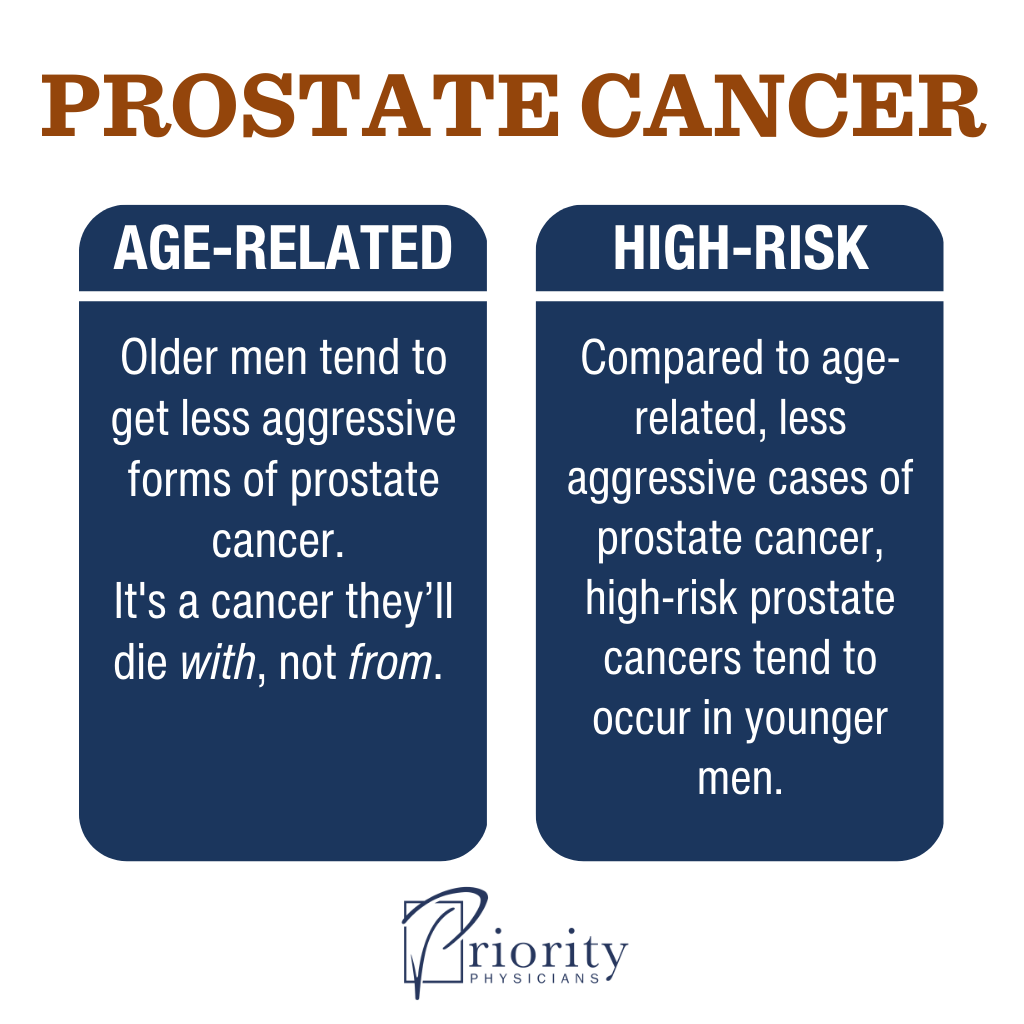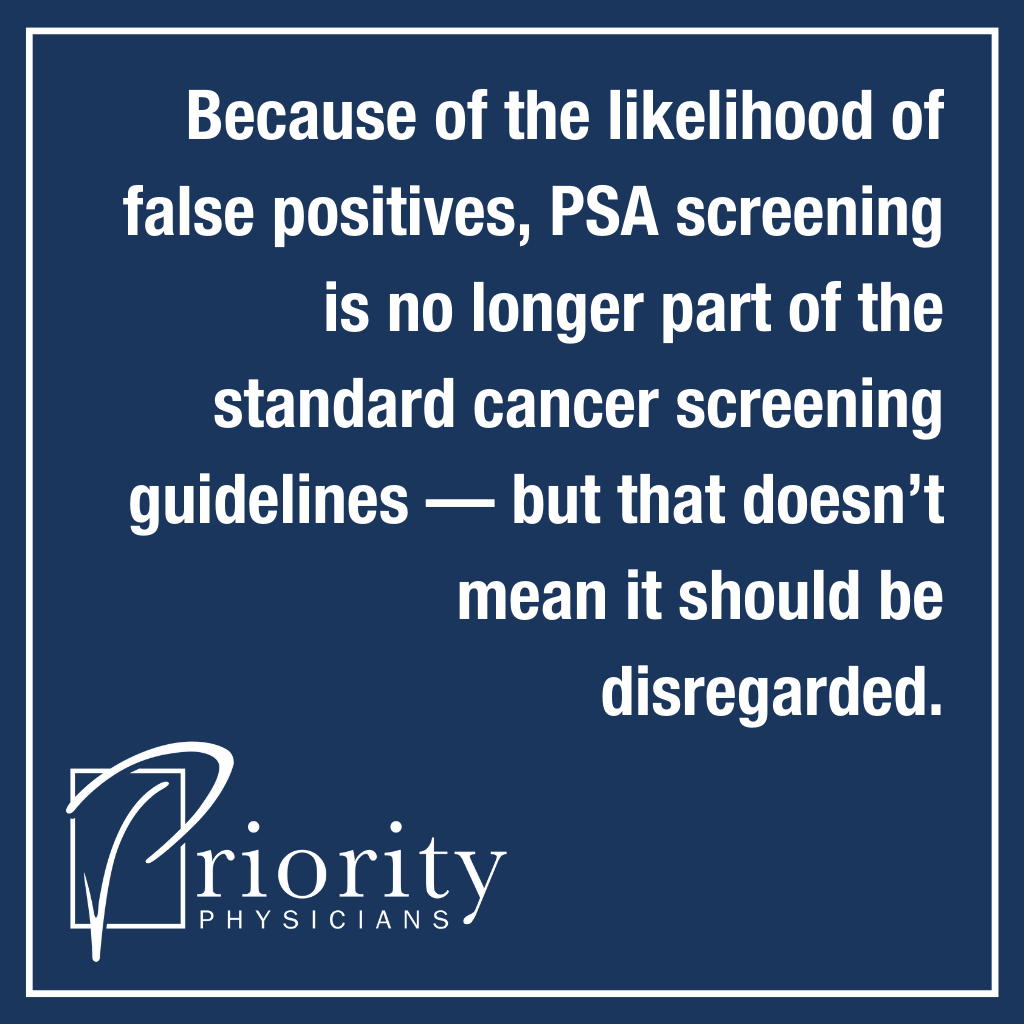Prostate cancer is the most common cancer in males. In fact, 80% of men will develop it by the time they’re 80.
But why is it so common?
A normal prostate continually grows with age — it’s bigger at 50 years old than it was at 40 years old than it was at 30 years old. Just like everything else that grows with age, that growth may not be as clean at age 70 as it was at age 20. The issue, then, becomes differentiating a normal, aging prostate from a cancerous prostate.
We tend to separate prostate cancer into two categories: age-related prostate cancer and high-risk prostate cancer.
Let’s review the differences.

Age-Related Prostate Cancer
Just like every other form of cancer, you want to catch prostate cancer as early as possible — but there’s some controversy over how early detection should be done.
It baffles me that current medical guidelines don’t require screening for prostate cancer. This is largely because of the kind of testing used to screen for prostate cancer.
Prostate cancer is typically monitored using a prostate-specific antigen (PSA) test, which measures the level of those antigens in the blood. Prostate-specific antigens are proteins produced by prostate gland cells.
PSA values are generally correlated with the size of the prostate. Men with larger prostates may have higher PSA values, but that doesn’t necessarily mean they have cancer.
PSA testing needs to be done over time to track trends. We look for a certain velocity of change in results — going from a mostly flat trend of PSA values, or even a little rise over time, to a steeper curve.
It’s difficult to identify meaningful PSA levels. If you check your PSA levels regularly, you’re inevitably going to see an elevated PSA reading over time, correlating with the growth of your prostate. If you’re not careful, you’ll be referred to a urologist for a biopsy that might not be needed.
Because of the likelihood of false positives, PSA screening is no longer part of the standard cancer screening guidelines — but that doesn’t mean it should be disregarded.
PSA screenings should still be done, because catching prostate cancer early comes from tracking trends over time. A lot of older men taking these tests wonder whether they have “normal” PSA elevation or if they’re showing early signs of prostate cancer. That’s an okay place to be — if you do have prostate cancer, regular PSA testing means you’re going to catch it earlier.
That said, older men tend to get less aggressive forms of prostate cancer. It’s a cancer they’ll die with, not from. More aggressive, high-risk forms of prostate cancer more often occur in a different population.

High-Risk Prostate Cancer
Compared to age-related, less aggressive cases of prostate cancer, high-risk prostate cancers tend to occur in younger men.
Men can see elevated PSA levels as early as their 40s. Prostate cancer at this age tends to be much more aggressive, meaning we more often find it at later stages, when it has already spread.
Many things can cause an elevated PSA, but this kind of result needs to be taken seriously, especially in younger men.
Comparing Prostate Cancer Risk Categories
Since the two prostate cancer risk categories are very different beasts, our treatment responses are going to differ with each type.
If you get prostate cancer when you’re 80, we will deal with it, but we don’t have to go crazy with our treatment plan. However, if you’re 40 and you develop prostate cancer, we have to be aggressive. Typical approaches — radiation, anti-hormone treatments, or prostate removal — are the standard treatment, but there’s enormous value in catching this kind of cancer early. It’s why an annual physical is so important.
Unfortunately, most men in their 40s and 50s aren’t going to the doctor for their annual checkups, and even if they do, they may not receive PSA screening since it’s no longer part of the guidelines. This is a big issue. A 42-year-old man can see an evidence-based physician in America, get a physical, and leave without knowing they have aggressive prostate cancer because their PSA level was never checked.
That standard of care is not enough.
If you’re a man in your 40s, you need to get an annual PSA screening with your routine physical — if you’re a man in your 30s, do the same. The best way to protect against a false positive PSA screening is to have a lot of historical data to build out your trend.
I tell every man whose PSA I check, “I really don’t care what objective number your PSA level is. What I care about is following that trend over time. I want to reflect on this data in a few years as we develop that trend.”
The best way to do that is to start annual PSA screenings as soon as possible.
The Gleason Score
We grade the aggressiveness of prostate cancers using a metric called a Gleason score. It’s actually two values, each rated one through five, added together to get a score of two through ten.
Physicians generally agree scores of five and below are not cancerous — they’re signs of normal aging. On the other hand, we generally agree scores of seven and above indicate cancer. There’s a lot of debate about what to do with Gleason scores of six.
Unfortunately, most prostate biopsies from older men seem to come back with a Gleason score of six, and most biopsies from younger men come back with a score of seven. We need to approach these scores carefully and consider treatment plans that make the most sense for each individual patient.
Prostate Cancer Risk Stratification: Final Thoughts
The best way to catch high-risk prostate cancer early, when it’s most treatable, is to build out a years-long PSA trend, ideally starting in your 30s.
If you want to learn more about your PSA levels, ask your doctor to check them as part of your annual physical. It may save you a ton of time, energy, and worry down the road.

